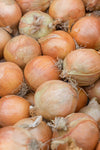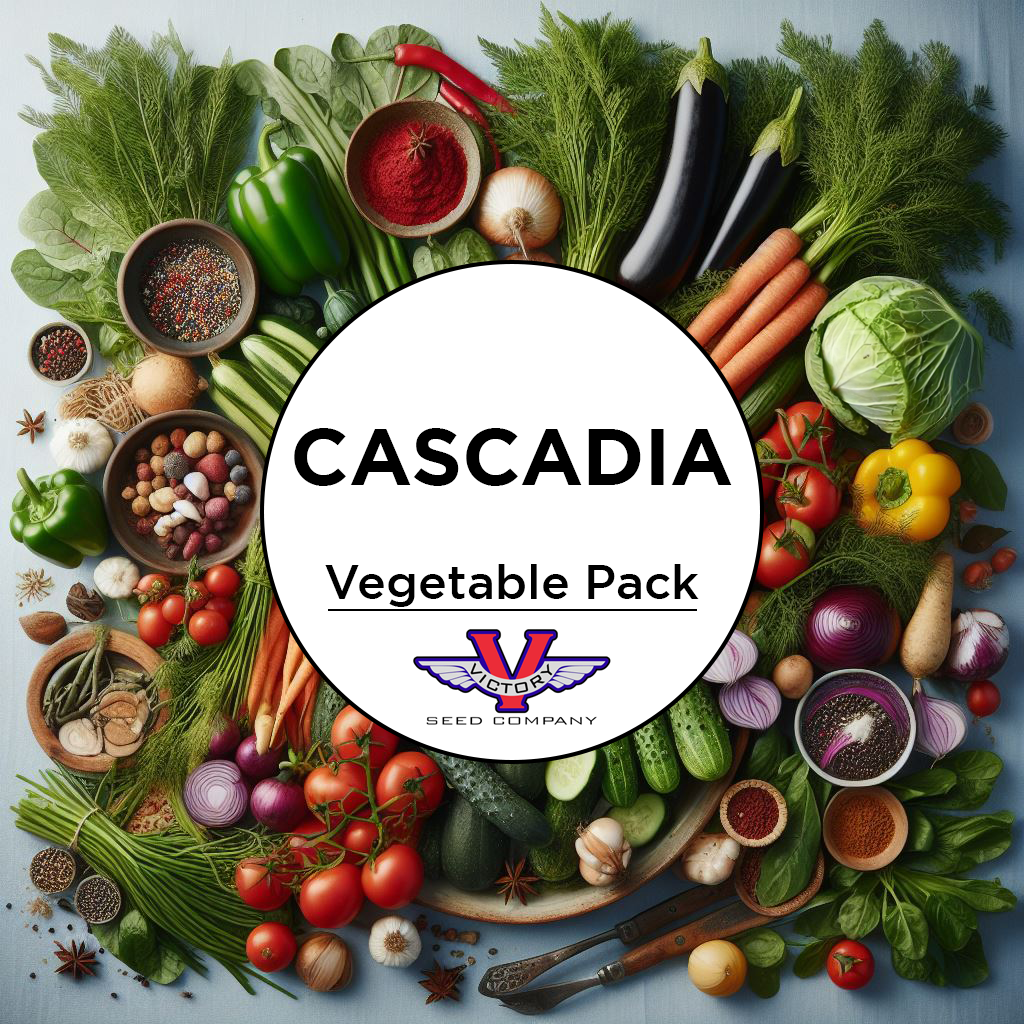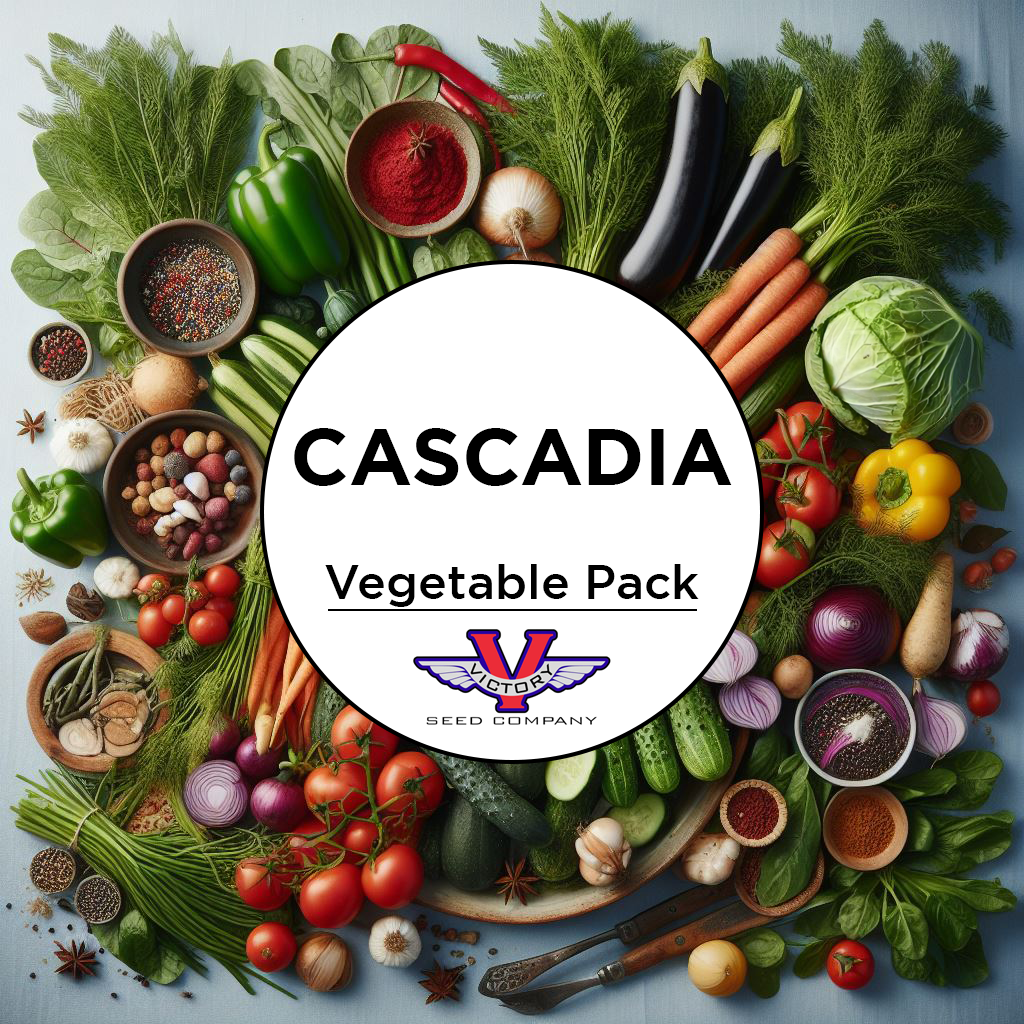Cascadia Vegetable Garden Pack
Cascadia Vegetable Garden Pack
Regular price
$94.99 USD
Regular price
$99.35 USD
Sale price
$94.99 USD
Unit price
per
Shipping calculated at checkout.
Couldn't load pickup availability
We have chosen our favorite and best-selling varieties for the beautiful Cascadia region (Oregon, Washington, and Vancouver BC) and made them available in this convenient collection.
Place a single order for this item and you will get one packet of each of the items shown below at an overall discount. If you prefer, you can order them individually one by one, by clicking on each item in the list.
 Basil, Italian Large Leaf (Sweet)
Basil, Italian Large Leaf (Sweet)
Germination: 5 to 7 days A native to Europe and cultivated for centuries as a fresh and dried culinary herb. Common in America by the late 1700s. The plants grow to about eighteen inches, and provide several harvests. The leaves are used fresh to make pesto, and can be dried and used as a seasoning. A favorite in Italian dishes. Prefers well-drained soil, even moisture, and full sun.
 Blue Lake 274 Bush Green Bean
Blue Lake 274 Bush Green Bean
Pick the pods while young as they are more tender and succulent and less likely to be stringy. This variety is a canner's favorite as it tends to mature its heavy crop all at once.
 Detroit Dark Red Beet
Detroit Dark Red Beet
Very tasty fresh out of the garden, it also maintains its taste and texture well after being canned or pickled. Globe shaped, excellent color, sweet, smooth and tender.
 Di Ciccio Broccoli
Di Ciccio Broccoli
An old European variety Introduced in 1890. Compact, 2 to 3 feet high plants, that produce a central 3 to 4 inch head with many side shoots. Freezes well.
 Catskill Brussels Sprouts
Catskill Brussels Sprouts
The 20 to 24 inch tall plants produce heavily. The sprouts are large (up to 1¾ inches), dark-green and firm. Used for fall harvests, it is good fresh or frozen. Developed in 1941.
 All Seasons Cabbage
All Seasons Cabbage
Also known as 'Vandergaw', this variety is heat resistant, fine-flavored and produces good, hard heads that are ten inches in diameter, average about 12 pounds and are round but flattened on top. Released in 1886.
 Henderson's Tendersweet Carrot
Henderson's Tendersweet Carrot
'Henderson's Tendersweet' carrot plants have a distinct, dark green foliage. When the roots reach full maturity, they are a deep orange color, average from eight to ten inches in length, and taper slightly from the shoulder to a blunt end.
 Early Snowball Cauliflower
Early Snowball Cauliflower
Uniform maturing, smooth, pure white heads weighing three to five pounds and six inches across. It is a medium sized plant with good leaf coverage. Released in 1941. It is reliable. Freezes well also.
 Perpetual Swiss Chard
Perpetual Swiss Chard
Leaves are smooth, dark-green in color with fine midribs. It is very vigorous and provides an almost "perpetual" harvest. If you garden in an area with a hot climate, it is a great choice for a continuous supply of tasty summertime greens.
 Golden Bantam Sweet Corn
Golden Bantam Sweet Corn
The plants grow to about six feet and produce seven inch ears loaded with eight rows of sweet, plump, golden kernels. Bred by a farmer named William Chambers of Greenfield, Mass. Introduced by W. Atlee Burpee in 1902. Prior to this introduction, people thought that yellow corn was fit only for animal feed.
 Lemon (Apple) Cucumber
Lemon (Apple) Cucumber
Vigorous and productive. Fruit are crispy white, sweet, and burpless, about the size and color of a lemon, and ripe when it first starts to turn yellow; can be used when green. A very old variety (about 1894).
 Straight Eight Cucumber
Straight Eight Cucumber
The vigorous and productive plants yield dark green, blunt ended, cylindrical, 7 to 8 inch long fruit. A good slicing variety.
 Cinderella Pumpkin
Cinderella Pumpkin
Fruits are flattened, deeply ribbed, and concave on top. They average 15 inches across and only 6 inches high weighing up to 25 pounds. The skin color is a brilliant reddish-orange and have an excellent flavor for pies or winter squash recipes.
 Waltham Butternut Winter Squash
Waltham Butternut Winter Squash
Light tan, seven to nine inches long with a thick neck and a small seed cavity. The flesh is a wonderful, bright orange. An "All-American Selection®" in 1970.
 Black Beauty Zucchini Summer Squash
Black Beauty Zucchini Summer Squash
The bush-type plants of 'Black Beauty' zucchini are early and very productive. Although you can use this summer squash at just about any size, we start picking fruit when they are about six to eight inches long by two inches in diameter and dark green in color. We prefer them at this young and tender stage when they are excellent lightly steamed, sautéed, or stir-fried. They reach a black-green to almost black at maturity.
 Early Prolific Straightneck Summer Squash
Early Prolific Straightneck Summer Squash
Best harvested (our opinion) when the fruit is five to six inches long and still tender. Mature size is 12 to 14 inches.
 Diamond Eggplant
Diamond Eggplant
70 days — Diamond Eggplant is a beautiful and versatile variety of eggplant that produces large (6-9 inch), deep purple fruits that are glossy and smooth. This eggplant variety is prized for its sweet and delicate flavor, making it a favorite among gardeners and chefs alike.
 Arugula
Arugula
Also known as rocket or roquette and is popular in Italian cuisine. Adds an interesting tangy flavor to an otherwise bland salad. All plant parts are edible and harvest is enjoyed over a long period as it is a cut and come again plant. It prefers cool weather so start sowing successive plantings directly in the garden as soon as the soil can be worked in the spring. Also try an early to mid-fall planting in a cold frame or greenhouse for harvest throughout the winter. Sow seed ¼ inch deep in a location that receives full sun to partial shade. Best soil temperatures for germination is 40 to 50ºF. Sow about one inch apart thinning plants to a spacing of about six inches. Harvest when the leaves are 2 to 3 inches long.
 Dwarf Blue Curled Scotch Kale (Vates)
Dwarf Blue Curled Scotch Kale (Vates)
The leaves are finely curled, bluish green, low growing at twelve to fifteen inches tall with a spread of twenty four to thirty inches. It stands well and is hardy.
 All The Year Round Butterhead Lettuce
All The Year Round Butterhead Lettuce
Medium-sized heads stay firm and solid even in hot weather. Can be sown in most locations from about March through August for a nearly "year-round" harvest periods. It does well in both hot and cooler locations.
 Honey Rock Melon
Honey Rock Melon
The fruits are up to 6 inches in diameter with a tough, coarsely netted skin and sweet, flavorful salmon colored flesh. The plants are vigorous, produce 5 to 7 fruits per plant and are disease resistant. Introduced in about 1920.
 Yellow Sweet Spanish Onion
Yellow Sweet Spanish Onion
Extra large (up to six inch) globe shaped onion. The skin is a straw color and the flesh is white. It has a popular mild and sweet flavor. 'Yellow Sweet Spanish' is an indeterminate variety that reportedly does well in long day regions and stores well.
 Italian Parsley
Italian Parsley
Plants have deeply cut, dark green leaves with a rich, strong flavor; generally stronger in flavor than the curled types. Excellent for flavoring. Parsley has been cultivated for centuries and is used as a garnish, palate cleanser, flavoring in soups, salads, as a seasoning in other recipes, and medicinally.
 Sugar Ann Sugar Snap Pea
Sugar Ann Sugar Snap Pea
The plants range from 24 to 30 inches and do not require support, though they do benefit from it. The pods are crisp, flavorful, three inch snap peas. Great fresh, in stir fry or frozen.
 Golden California Wonder Bell Pepper
Golden California Wonder Bell Pepper
The plants are upright, strong, and produce 4 or 5 fruits that are mostly four-lobed, blocky, and 4 by 4½ inches with thick flesh that is mild and sweet. The skin is a bright gold, changing to orange-red when mature.
 Jalapeno Hot Pepper
Jalapeno Hot Pepper
The fruit are dark green, tapered, three inches by one inch, turning red when mature. Good for pickling or used fresh in salsas. They have thick walls so do not dry well. They can range from 2,500 to 10,000 Scoville units in heat.
 French Breakfast Radish
French Breakfast Radish
These radishes are oblong with a blunt tip. The skin is scarlet with white tips and they have crisp, white flesh. They have a great, mildly pungent taste. Introduced prior to the 1880s.
 Bloomsdale Longstanding Spinach
Bloomsdale Longstanding Spinach
Leaves are dark green and crumpled. Stands well in hot weather. Named after their farm in Bristol, PA, D. Landreth & Co. released ‘Bloomsdale’ in the 19th century. 'Long Standing Bloomsdale' was developed and introduced in 1925 by Zwaan and Van der Molen, Voorburg, Netherlands.
 Sunflower, Giant Greystripe
Sunflower, Giant Greystripe
Planting Instructions: Sunflowers are very easy to grow and because of their size, quite spectacular for a child’s garden. Sow directly outdoors, ¾ inches deep. Thin the plants at first to 8 inches and then to two feet to avoid crowding. (We have had good luck transplanting) Water regularly and weed between the plants to eliminate competition. Harvest the seeds by cutting the flowering heads when the backs have turned yellow. Complete the drying by hanging them upside down in a warm, dry place. Scan the QR code below for more information.
 Oregon Star Tomato
Oregon Star Tomato
80 days, determinate — Early maturing, red, firm, paste-type tomato. Easy to pick and peel. Large, irregularly shaped, with few seeds. Keeps well both on and off plant and are good for slicing as well as processing.
 Dwarf Eagle Smiley Tomato
Dwarf Eagle Smiley Tomato
60 days, dwarf — Extremely productive, rugose, regular leaf plants reach 5-feet tall. Bright to golden-yellow, 1oz, globe-shaped fruit that are borne in clusters of 8 to 10 tomatoes.
 Purple Top White Globe Turnip
Purple Top White Globe Turnip
Round roots that are bright purple on the upper part and white below. The globes grow four to five inches in diameter but are best when harvested a little smaller.
 Sugar Baby Watermelon
Sugar Baby Watermelon
The best and most popular small or icebox melon around. One of the sweetest and earliest melons with very small seeds. Fairly tough, thin rind which keeps for a long time.
Place a single order for this item and you will get one packet of each of the items shown below at an overall discount. If you prefer, you can order them individually one by one, by clicking on each item in the list.
 Basil, Italian Large Leaf (Sweet)
Basil, Italian Large Leaf (Sweet)Germination: 5 to 7 days A native to Europe and cultivated for centuries as a fresh and dried culinary herb. Common in America by the late 1700s. The plants grow to about eighteen inches, and provide several harvests. The leaves are used fresh to make pesto, and can be dried and used as a seasoning. A favorite in Italian dishes. Prefers well-drained soil, even moisture, and full sun.
 Blue Lake 274 Bush Green Bean
Blue Lake 274 Bush Green BeanPick the pods while young as they are more tender and succulent and less likely to be stringy. This variety is a canner's favorite as it tends to mature its heavy crop all at once.
 Detroit Dark Red Beet
Detroit Dark Red BeetVery tasty fresh out of the garden, it also maintains its taste and texture well after being canned or pickled. Globe shaped, excellent color, sweet, smooth and tender.
 Di Ciccio Broccoli
Di Ciccio BroccoliAn old European variety Introduced in 1890. Compact, 2 to 3 feet high plants, that produce a central 3 to 4 inch head with many side shoots. Freezes well.
 Catskill Brussels Sprouts
Catskill Brussels SproutsThe 20 to 24 inch tall plants produce heavily. The sprouts are large (up to 1¾ inches), dark-green and firm. Used for fall harvests, it is good fresh or frozen. Developed in 1941.
 All Seasons Cabbage
All Seasons CabbageAlso known as 'Vandergaw', this variety is heat resistant, fine-flavored and produces good, hard heads that are ten inches in diameter, average about 12 pounds and are round but flattened on top. Released in 1886.
 Henderson's Tendersweet Carrot
Henderson's Tendersweet Carrot'Henderson's Tendersweet' carrot plants have a distinct, dark green foliage. When the roots reach full maturity, they are a deep orange color, average from eight to ten inches in length, and taper slightly from the shoulder to a blunt end.
 Early Snowball Cauliflower
Early Snowball CauliflowerUniform maturing, smooth, pure white heads weighing three to five pounds and six inches across. It is a medium sized plant with good leaf coverage. Released in 1941. It is reliable. Freezes well also.
 Perpetual Swiss Chard
Perpetual Swiss ChardLeaves are smooth, dark-green in color with fine midribs. It is very vigorous and provides an almost "perpetual" harvest. If you garden in an area with a hot climate, it is a great choice for a continuous supply of tasty summertime greens.
 Golden Bantam Sweet Corn
Golden Bantam Sweet CornThe plants grow to about six feet and produce seven inch ears loaded with eight rows of sweet, plump, golden kernels. Bred by a farmer named William Chambers of Greenfield, Mass. Introduced by W. Atlee Burpee in 1902. Prior to this introduction, people thought that yellow corn was fit only for animal feed.
 Lemon (Apple) Cucumber
Lemon (Apple) CucumberVigorous and productive. Fruit are crispy white, sweet, and burpless, about the size and color of a lemon, and ripe when it first starts to turn yellow; can be used when green. A very old variety (about 1894).
 Straight Eight Cucumber
Straight Eight CucumberThe vigorous and productive plants yield dark green, blunt ended, cylindrical, 7 to 8 inch long fruit. A good slicing variety.
 Cinderella Pumpkin
Cinderella PumpkinFruits are flattened, deeply ribbed, and concave on top. They average 15 inches across and only 6 inches high weighing up to 25 pounds. The skin color is a brilliant reddish-orange and have an excellent flavor for pies or winter squash recipes.
 Waltham Butternut Winter Squash
Waltham Butternut Winter SquashLight tan, seven to nine inches long with a thick neck and a small seed cavity. The flesh is a wonderful, bright orange. An "All-American Selection®" in 1970.
 Black Beauty Zucchini Summer Squash
Black Beauty Zucchini Summer SquashThe bush-type plants of 'Black Beauty' zucchini are early and very productive. Although you can use this summer squash at just about any size, we start picking fruit when they are about six to eight inches long by two inches in diameter and dark green in color. We prefer them at this young and tender stage when they are excellent lightly steamed, sautéed, or stir-fried. They reach a black-green to almost black at maturity.
 Early Prolific Straightneck Summer Squash
Early Prolific Straightneck Summer SquashBest harvested (our opinion) when the fruit is five to six inches long and still tender. Mature size is 12 to 14 inches.
 Diamond Eggplant
Diamond Eggplant70 days — Diamond Eggplant is a beautiful and versatile variety of eggplant that produces large (6-9 inch), deep purple fruits that are glossy and smooth. This eggplant variety is prized for its sweet and delicate flavor, making it a favorite among gardeners and chefs alike.
 Arugula
ArugulaAlso known as rocket or roquette and is popular in Italian cuisine. Adds an interesting tangy flavor to an otherwise bland salad. All plant parts are edible and harvest is enjoyed over a long period as it is a cut and come again plant. It prefers cool weather so start sowing successive plantings directly in the garden as soon as the soil can be worked in the spring. Also try an early to mid-fall planting in a cold frame or greenhouse for harvest throughout the winter. Sow seed ¼ inch deep in a location that receives full sun to partial shade. Best soil temperatures for germination is 40 to 50ºF. Sow about one inch apart thinning plants to a spacing of about six inches. Harvest when the leaves are 2 to 3 inches long.
 Dwarf Blue Curled Scotch Kale (Vates)
Dwarf Blue Curled Scotch Kale (Vates)The leaves are finely curled, bluish green, low growing at twelve to fifteen inches tall with a spread of twenty four to thirty inches. It stands well and is hardy.
 All The Year Round Butterhead Lettuce
All The Year Round Butterhead LettuceMedium-sized heads stay firm and solid even in hot weather. Can be sown in most locations from about March through August for a nearly "year-round" harvest periods. It does well in both hot and cooler locations.
 Honey Rock Melon
Honey Rock MelonThe fruits are up to 6 inches in diameter with a tough, coarsely netted skin and sweet, flavorful salmon colored flesh. The plants are vigorous, produce 5 to 7 fruits per plant and are disease resistant. Introduced in about 1920.
 Yellow Sweet Spanish Onion
Yellow Sweet Spanish OnionExtra large (up to six inch) globe shaped onion. The skin is a straw color and the flesh is white. It has a popular mild and sweet flavor. 'Yellow Sweet Spanish' is an indeterminate variety that reportedly does well in long day regions and stores well.
 Italian Parsley
Italian ParsleyPlants have deeply cut, dark green leaves with a rich, strong flavor; generally stronger in flavor than the curled types. Excellent for flavoring. Parsley has been cultivated for centuries and is used as a garnish, palate cleanser, flavoring in soups, salads, as a seasoning in other recipes, and medicinally.
 Sugar Ann Sugar Snap Pea
Sugar Ann Sugar Snap PeaThe plants range from 24 to 30 inches and do not require support, though they do benefit from it. The pods are crisp, flavorful, three inch snap peas. Great fresh, in stir fry or frozen.
 Golden California Wonder Bell Pepper
Golden California Wonder Bell PepperThe plants are upright, strong, and produce 4 or 5 fruits that are mostly four-lobed, blocky, and 4 by 4½ inches with thick flesh that is mild and sweet. The skin is a bright gold, changing to orange-red when mature.
 Jalapeno Hot Pepper
Jalapeno Hot PepperThe fruit are dark green, tapered, three inches by one inch, turning red when mature. Good for pickling or used fresh in salsas. They have thick walls so do not dry well. They can range from 2,500 to 10,000 Scoville units in heat.
 French Breakfast Radish
French Breakfast RadishThese radishes are oblong with a blunt tip. The skin is scarlet with white tips and they have crisp, white flesh. They have a great, mildly pungent taste. Introduced prior to the 1880s.
 Bloomsdale Longstanding Spinach
Bloomsdale Longstanding SpinachLeaves are dark green and crumpled. Stands well in hot weather. Named after their farm in Bristol, PA, D. Landreth & Co. released ‘Bloomsdale’ in the 19th century. 'Long Standing Bloomsdale' was developed and introduced in 1925 by Zwaan and Van der Molen, Voorburg, Netherlands.
 Sunflower, Giant Greystripe
Sunflower, Giant GreystripePlanting Instructions: Sunflowers are very easy to grow and because of their size, quite spectacular for a child’s garden. Sow directly outdoors, ¾ inches deep. Thin the plants at first to 8 inches and then to two feet to avoid crowding. (We have had good luck transplanting) Water regularly and weed between the plants to eliminate competition. Harvest the seeds by cutting the flowering heads when the backs have turned yellow. Complete the drying by hanging them upside down in a warm, dry place. Scan the QR code below for more information.
 Oregon Star Tomato
Oregon Star Tomato80 days, determinate — Early maturing, red, firm, paste-type tomato. Easy to pick and peel. Large, irregularly shaped, with few seeds. Keeps well both on and off plant and are good for slicing as well as processing.
 Dwarf Eagle Smiley Tomato
Dwarf Eagle Smiley Tomato60 days, dwarf — Extremely productive, rugose, regular leaf plants reach 5-feet tall. Bright to golden-yellow, 1oz, globe-shaped fruit that are borne in clusters of 8 to 10 tomatoes.
 Purple Top White Globe Turnip
Purple Top White Globe TurnipRound roots that are bright purple on the upper part and white below. The globes grow four to five inches in diameter but are best when harvested a little smaller.
 Sugar Baby Watermelon
Sugar Baby WatermelonThe best and most popular small or icebox melon around. One of the sweetest and earliest melons with very small seeds. Fairly tough, thin rind which keeps for a long time.

Explore our vegetable collections:
[ Artichokes | Asparagus | Beans | Beets | Broccoli | Sorghums | Brussels Sprouts | Cabbage | Cantaloupe | Carrots | Cauliflower | Celery | Collard Greens | Corn | Cucumber | Eggplant | Endives | Gourds | Kale | Kohlrabi | Leeks | Lettuce | Mesclun Mix | Mustard Greens | Okra | Onions | Parsley | Edible Pod Peas | Garden Peas | South Peas | Hot Peppers | Mild Peppers | Pumpkins | Radishes | Rapini | Rhubarb | Salad Greens | Salsify | Summer Squash | Winter Squash | Swiss Chard | Tomatillo | Tomatoes | Dwarf Tomato Project | Turnips | Watermelons ]

